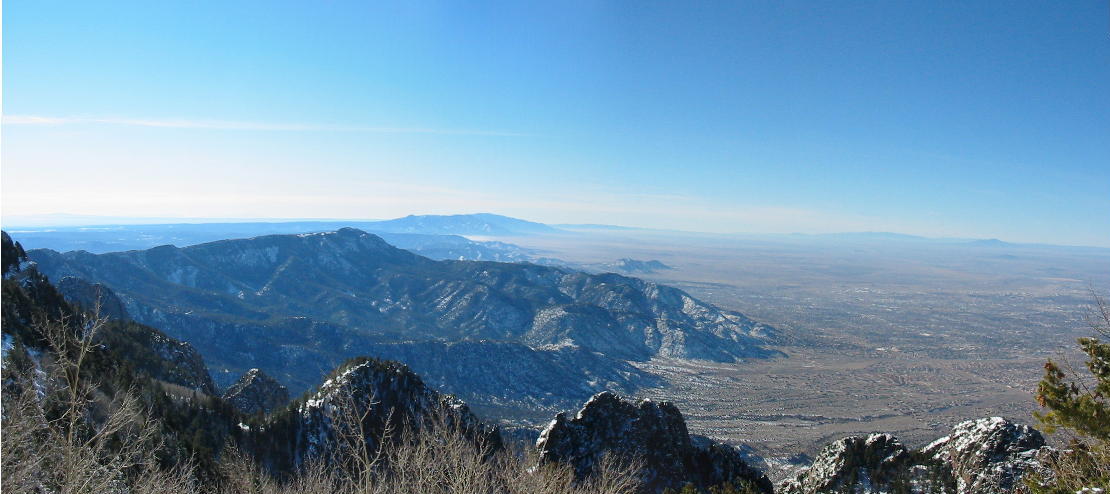View from Sandia Crest House, looking south to South Sandia Peak and the Manzano Mountains beyond (click for larger view):
The 43rd Annual La Luz Trail Run
The race finishes
at the Sandia Crest (10,678′) near the gift shop located by the radio and TV towers on the crest. There is a strict 400 runner limit imposed on the race by the U.S. Forest Service. In fall issue of 2001 Trail Runner Magazine, La Luz was selected as one of the “12 Most Grueling Trail Races in North America”.Race Director: Rodger Sack, (505) 797-0791
Frequent travel and lots of desk time took its toll on my constitution during my professional career. Mary Lou’s life centered around the increasing needs of our severly handicapped son, Glen, who remained with us at home for all his 24 years. In 1992, he passed away at our home in Dallas.
After we decided to retire from Dallas to the mountains of New Mexico, I resolved to improve my physical conditioning in preparation for a more active life at 7000 feet elevation. Mary Lou was very diligent in exercising at home, and whenever possible we took brisk morning walks. I lost a few more pounds by cutting the carbs. We also planned to take a much greater part in the life of our community.
Once settled into our new home, we both became very active in church ministries. I organized our new church’s first finance committee and served two terms as its chair. We hosted study groups and were responsible for scheduling several ongoing activities. I served on the board of our Homeowner’s Association and two terms as president. As soon as a class opened up, I took training as a docent at the Rio Grande Nature Center State Park in Albuquerque, and led walks for schoolchildren once a week. With the volunteer coordinator, we set up the first Saturday morning bird walks at RGNC, not sure whether anyone else would volunteer to lead them. We were delighted that the public responded positively, and many experienced birders offered to lead, and we were able to expand them to Sunday mornings. We then trained as volunteers with the US Forest Service and I served as a Wilderness Information Specialist. One of our “duties” was to walk the trails, on the lookout for fires and any problems such as downed trees, graffiti and washouts. It also led to our interest in the rosy-finches and creation of the feeding project that continues to this day.
I also joined the New Mexico Mountain Club, a group of senior citizen hikers. I figured it would be a piece of cake, as I had retired fairly young, and many members were 10 and 20 years older than me. I quickly found out otherwise, as these men and women were true “hikers.” Until then, “hiking” to me meant “bird hike,” which is merely a means to an end. For the Mountain Club, the hike was the end in itself. Even after I learned to adapt to their habits, I usually had fallen to the rear of the line, usually not out of exhausion, but because I could not resist slowing down or even stopping to enjoy a breathtaking view, or (of course) that Grace’s Warbler in a Ponderosa, or a Northern Goshawk flyover. The price I paid for tarrying was to catch up with the group just as they were finishing their 10 minute rest and water break!
I learned that hiking downhill was harder on my knees than up, but the regular weekly hikes allowed me to experience some wonderful natural areas in North Central New Mexico. One memorable hike was right up to the top of Sandia Crest from the northeast corner of Albuquerque, by way of La Luz Trail. This 7.2 mile dirt track starts at 7,000 feet altitude and zig-zags its way up to the 10,678 foot summit. The only ways back down would be to change direction and walk, or walk another mile to the south on the South Crest Trail to Sandia Peak and take the tram down. In the event that some of the group would choose the latter method, we parked a couple of cars at the bottom of the tram before we drove the rest to the starting point in the Juan Tabo Picnic Area.
We walked up La Luz on a delightful late spring morning. Happily, by then I had the benefit of having beefed up my quads on several earlier hikes with the group. There were about ten of us on the climb, about equally divided between men and women. It took us about four hours to the Crest, which averages less than two miles an hour, but the grade is 12% to that point. It was actually not as difficult as I had feared, but I thought about that last downhill hike. Our leader, who was a man in his early 80s, then asked who wanted to rest a while and then turn around and walk back. One woman, in her seventies, and all the other men said they did. I said, “I think I’ll take the tram with the other ladies.” We walked another half hour to reach the restaurant at the top of the Sandia Peak tram, had lunch, and then rode down. With great foresight, I had left my car at the base parking lot!
Last year, many runners finished the nine mile La Luz Trail Run with times under 1 1/2 hours. The average age of participants was 42 (age range 14-80) and the average time was 2:24. This annual event will be held this weekend. Spectators are welcome!
It is hot now in South Florida. Even early in the morning, the combination of heat, humidity and mosquitoes does not encourage birding or other outdoor pursuits. We will now retreat to Illinois, where the daily high temperatures are about the same as Florida’s lows.
Our wild birds are pretty quiet now, having raised their young. The Mockingbirds sing infrequently, and many species are undergoing molt, which saps their energy. My attention turns to the naturalized Muscovy Ducks that inhabit our lake.
Hen with nine ducklings on May 18, 2008:

After two seasons that were marked by die-offs, territorial squabbling, and infanticide that resulted in greatly reduced numbers of Muscovy Ducks on our lake, it appears that we are now witnessing a population boom. The drakes seem to have settled down and accepted a certain pecking order and rights over specific land areas and hens. The drakes have not shown any more unusual aggression towards the ducklings. “Old Whitey” now rules our yard and probably sired the youngsters that have hatched out on our property.
On May 18 of this year, I photographed a hen with a brood of 9 ducklings that she had been incubating under the cocoplum shrub in our back yard. One of the chicks was all yellow. That same day, I saw a large fish surface as if to attack one of them, but all the ducklings gathered in a tight group around their mother, and paddled safely away. (A couple of years earlier, a neighborhood child and I saw a chick disappear when a Largemouth Bass took it in one gulp, right before our eyes.)
The same nine ducklings, photographed exactly 2 months later, on July 18:
All these nine ducklings have survived the past two months, and are now nearly as large as the adults. The yellow one is now mostly white, and is the one closest to the camera. All nine can be seen in this photo– the additional birds are a Rock Pigeon and four adult Muscovy Ducks that are in and near the water, behind the ducklings. Their survival to this age is quite unusual, as there has been nearly 100% mortality up to now. Also unusual is the fact that all nine have stayed together after reaching this size. Perhaps this has helped them to escape predators.
Now a different hen has a new brood of 10 ducklings that hatched out around July 14. There are three yellow chicks in this family. We will try to keep track of these as well.

You know it is very hot when… this White Ibis seeks the shade of our little mango tree.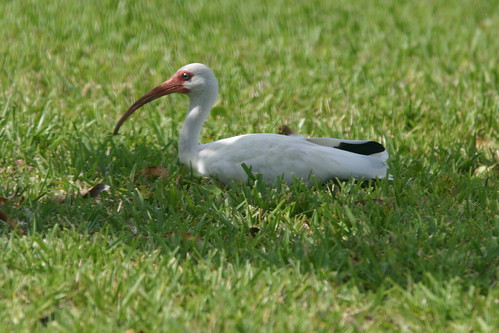
A Parade of Ibises

At once grotesque and stunningly beautiful, the ibis was venerated by the ancient Egyptians because of its association with the Nile River, the source and protector of life. A hieroglyph in the form of an ibis represented Thoth, one of the most important gods, mediator of good and evil, creator of the 365 day calendar and inventor of the hieroglyph method of writing. Florida folklore regards the ibis (mascot of the University of Miami) as a bit more humble a hero, the last creature to take shelter before a hurricane and the first to reappear afterward.
As a kid in New Jersey, in addition to the White and Glossy Ibis, I memorized the pictures of the Wood Ibis. To my mind, all three represented truly exotic creatures that, one day, I hoped to see.The Wood Ibis was subsequently upgraded to Wood Stork, but the classification of these birds remains in flux, as discussed in this interesting Wikipedia entry.
When I was 12 years old, I sighted a Glossy Ibis in Troy Meadows, New Jersey. My view was a drop-dead match for the picture in Peterson, but none of the older birders at the Hackensack Audubon Society considered my observation to be credible. The Glossy Ibis, an African native, had wandered to the US, by way of South America, only about 50 years before. No Glossy Ibis had been seen in the northern part of the state in over 10 years. Later that year, others were seen in the same location (and they are now fairly common there and northward up the Atlantic Coast), but my sighting was never made part of the “official” record. I blogged about my early-teen anguish in this entry: Quest for Rare Birds.
As commonplace as the White Ibis may be, as it walks our Florida neighborhood lawns and even breaks open garbage bags to obtain snacks, I cannot help but stop and stare when I see one. These three walked along the margin of our lake, seemingly in a great hurry. Two retained some dark head and body feathers, indicating they had hatched out this year. An adult-plumage bird followed closely behind. Might it possibly have been one of their parents?
Adult Ibis walking along the shore of our lake: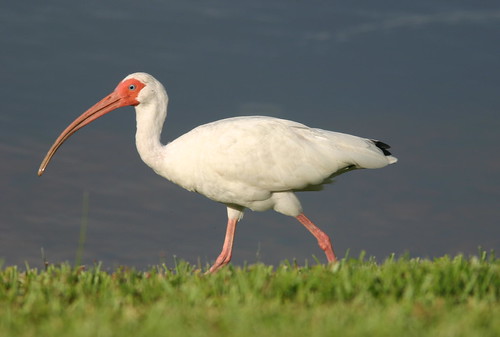
It was following these two immature Ibises:
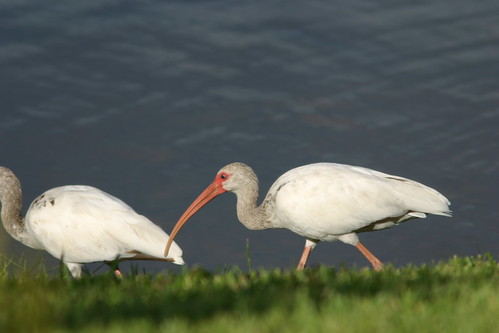
Loggerhead Shrike on our patio seems fascinated by a leaf from our Travelers Palm:
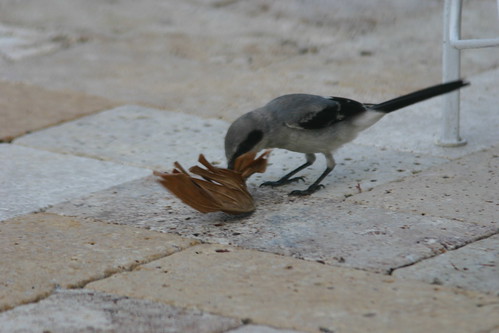
After constructing our patio addition, there were some left-over travertine tiles. I used them to create a small attached area for our barbecue.We planted three Traveler’s Palms in a line next to it, and they provided a privacy screen of sorts. Traveler’s Palms are not true palms, but are classified in a family all its own and look rather more like a banana plant. Native only to Madagascar, it gets its name from the fact that its leaves and stalks, which grow in a single vertical plane, collect and store large quantities of water (available for any thirsty “traveler”). Its flowers, which somewhat resemble those of the Bird-of-Paradise (a West African native that is in the banana family), bloom the year around, and its fruits attract insects, especially ants. Lizards and birds come to drink its water and feast on the insects.
Flower bracts of Traveler’s Palm in patriotic red, white and blue:
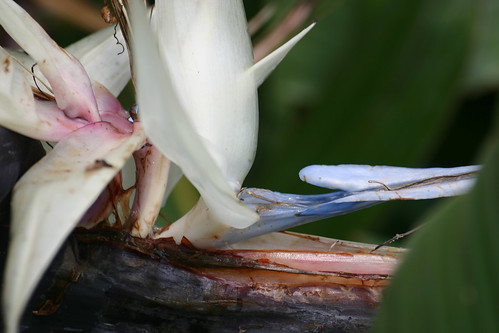
This photo demonstrates the interesting stalks, all arranged in one plane:
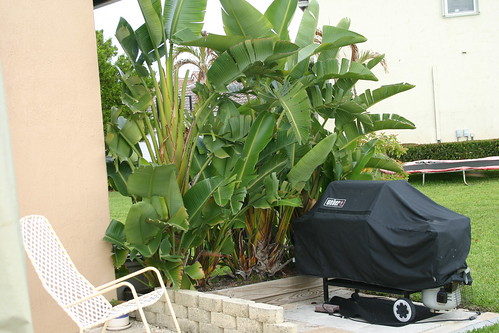
Between rain showers, I noted a Loggerhead Shrike on the back patio, hopping along and carrying a dead leaf from one of our Travelers Palms. It almost seemed to be playing with it, as it positioned it like a flag and carried it about for several minutes. Since the behaviors of wild creatures are purposeful, and usually carry some survival value, I observed the shrike more closely to see if there was some purpose. I photographed it through the patio windows, so the quality of the shots is sub-par.
The shrike shook the leaf repeatedly, flew up an dropped it several times, and carried it to several different perches, where it held the leaf with its feet while it probed towards the area of it stem. My best guess is that the shrike saw some prey item, whether an insect or a lizard or tree frog, hide itself in the folds of the leaf. The tubular stems that hold water may also provide hollows of varying sizes that could shelter all sorts of creatures. In any event, the shrike finally gave up its quest, apparently without obtaining any reward for its efforts.
The Shrike carried the leaf up to a lawn chair…:
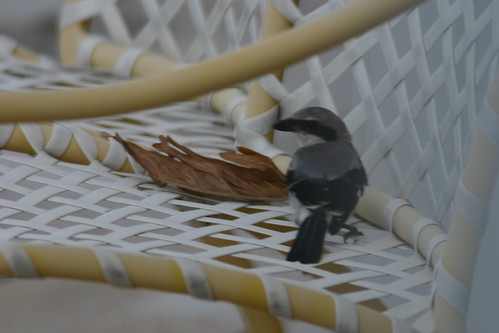
…and then, over to a table:
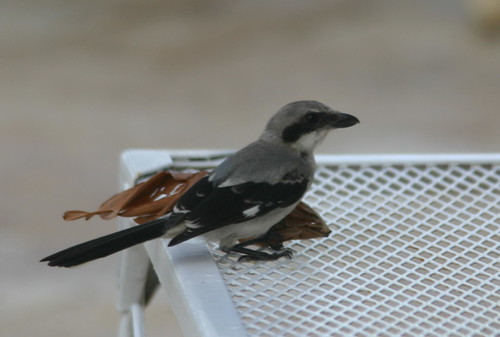
July 18, 2008– ADDENDUM TO THIS POST:
Excerpt From Kenn Kaufman’s Web site,
“Some elements within the energy industry have been trying for years to get the Arctic National Wildlife Refuge in Alaska opened up for for oil drilling. So far, such attempts have been voted down by congress. But the current high gasoline prices are seen by some as an opportunity to reopen the debate.
“The issue has suffered from some overheated rhetoric on both sides, with the pro-drilling factions accusing ‘environmental extremists’ of causing the current high gasoline prices. A calmer assessment of the potential for oil in the Arctic Refuge can be found in a May 2008 report prepared by the Department of Energy. Their best estimate is that oil from the Arctic Refuge could lower the cost of gasoline at the pump by a little less than four cents per gallon, with the first effects felt in 2018 and maximum impact in 2027-2028. Given the current progress on alternative energy sources and alternative vehicles, we can reasonably ask whether this savings of less than one percent, achieved 20 years from now, is worth the risk to the environment of the Arctic…” (Read entire article)
Today’s news juxtaposed two very different stories.
The first, reported by Dr. Jeff Wells, of the Boreal Songbird Initiative, is about how an enlightened Provincial government has set aside a 225,000 square kilometer “swath of northern boreal forest larger than the Maritime provinces… [R]oughly half of Ontario’s boreal forest - will be protected and designated strictly for tourism and traditional aboriginal use.” Full text of article
[ADDITIONAL INFORMATION POSTED IN COMMENTS BELOW]
The other story is sad indeed, as one of our own elected representatives plans to make a visit to the Arctic National Wildlife Refuge (ANWR) this weekend, as he is skeptical that any wildlife even live in that “barren” land. House Minority Leader John Boehner explains the reason for his visit: “But I understand there’s none there. But I’m still going to look for it. If I find any, I’ll let you know.” Full story at FoxNews.com
Instead of wasting taxpayer money on such a venture, our leader should first take a peek at the ANWR Web site,
To save him time and money, and the trouble of making a startling announcement on his return, he also could simply consult an FAQ on the ANWR Web site itself, which states that “[t]he only endangered species that may reach the Refuge is the Spectacled Eider. These birds, however, generally nest further west, so even if they were not reduced in number it is very rare for one to appear on the Refuge. There are no other species in the Refuge that are either threatened or endangered.”
Guaranteed! He will not see even one endangered species! I can’t wait to hear his big announcement upon returning from his weekend “safari.” I wonder how long his bird list will be, as many of the breeders have already packed up and headed south.
BirdBlogBytes
Save Our Boreal Birds
“300 Million Birds Say Thanks” for one of the most significant conservation actions in history
Audubon Action
Petition US government to minimize ecologic impact of Border Wall
The BirdFreak
Mining for Declining Birds
It’s a Bird Thing
Judy’s essays on New Mexico birding. Makes me miss the place even more!
Aimophila Adventures
EEW! Rick Wright goes “birding in the buff” (sans binos)
Bird Watchers Digest
Bill’s Top Ten List of almost anything a birder needs to know
Passionate Birder
On the Evolution of a Birder
Janine Images
My South Florida neighbor’s stunning wildlife photos
Urban Hawks
The urban raptors of Manhattan have had a “horrible” year
Today’s Chuckle
Rep.
Boehner Skeptical Wildlife Lives in Arctic National Wildlife Refuge–
“But I understand there’s none there. But I’m still going to look for
it. If I find any, I’ll let you know.”













